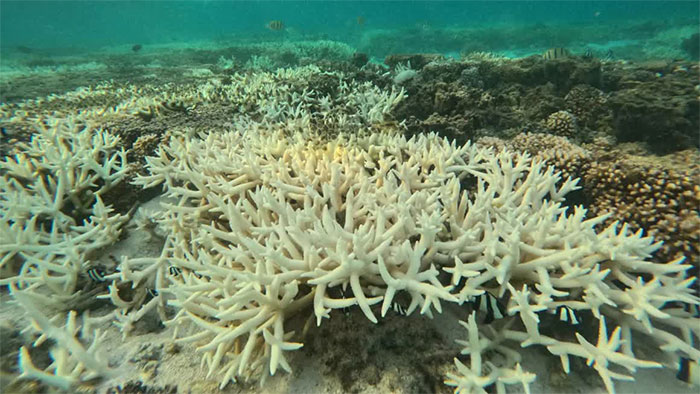The world is experiencing mass coral bleaching
Some experts also warn this could become the worst bleaching period in recorded history .
" More than 54% of the world's coral reefs have bleached in the past year , affecting at least 53 countries and territories including large areas of the Atlantic, Pacific and Indian Oceans. " , said a joint statement from the National Oceanic and Atmospheric Administration (NOAA) and the International Coral Reef Initiative (ICRI).
Ecologist Derek Manzello, coordinator of NOAA's Coral Reef Watch, which globally monitors the risk of coral bleaching, said it's likely the phenomenon will soon surpass its peak of 56. 1% previously. The rate at which reef areas will experience bleaching has been increasing by about 1% each week.

Coral bleaching at Lady Elliot Island of the Great Barrier Reef, on February 19, 2024. Photo: Rebecca Wright / CNN
When corals are stressed from marine heat waves, they release algae that live in their tissues. If ocean temperatures do not return to normal, bleaching could lead to mass deaths of coral, threatening the collapse of species and the food chain that depends on them.
This marks the world's fourth global bleaching event and the second in the past decade - following previous episodes in 1998, 2010 and between 2014-2017.
Over the last year, mass bleaching has been confirmed in areas including Florida and the wider Caribbean, Mexico, Brazil, Australia, the South Pacific, the Red Sea, the Persian Gulf, Indonesia and India The Ocean includes the east coast of Africa and the Seychelles.
Professor Ove Hoegh-Guldberg, a climate scientist specializing in coral reefs based at the University of Queensland in Australia, predicted this mass bleaching phenomenon months ago.
"We know sea temperatures are rising rapidly, but not at this rate. The concern is that we don't know how long these large temperature changes may last ," said Mr. Hoegh-Guldberg. .
The past 12 months have been the hottest on record on the planet and ocean temperatures have skyrocketed. According to data from the European Commission's Copernicus Climate Change Facility, global sea surface temperatures reached record highs in February and again in March.
In February, scientists at NOAA's coral reef monitoring program added three new alert levels to the coral bleaching warning map, helping scientists assess the new scale of the phenomenon. heats up underwater.
La Nina phenomenon
La Nina is a phenomenon in which the sea surface in the central and eastern equatorial Pacific Ocean is colder than normal.
El Niño , a natural climate pattern that originates in the Pacific Ocean along the equator and tends to push global temperatures upward, has contributed to unprecedented increases in ocean temperatures.
NOAA predicts that the La Niña phenomenon could come from June to August this year, bringing a "glimmer of hope" to coral reefs. However, bleaching has still occurred during La Niña periods over the past few years.
In mid-February this year, widespread coral bleaching occurred on Australia's Great Barrier Reef - the world's largest coral reef system - on five different reefs across the Northern region. and the South.
The mass bleaching was also officially confirmed last month following aerial and underwater surveys by the Australian Institute of Marine Science (AIMS) and the Great Barrier Reef Marine Park Authority.
Mr. Selina Stead, CEO of AIMS, noted that the increasing frequency and severity of marine heat waves due to climate change are testing the resilience of coral reefs. Climate change is the biggest threat to the world's coral reefs and this global confirmation shows the impact has been widespread over the past 12 months.
"That's why the world must work to reduce carbon emissions. It's also important to ensure coral reefs are well managed at local and regional levels ," Mr. Stead added.
The United Nations Environment Program has warned that if the world does not actively reduce emissions, the planet will warm nearly 3 degrees Celsius above pre-industrial levels this century.
Scientists also warn that when temperatures increase by 2 degrees - a level the world may reach around 2050 - about 99% of corals on Earth will die.
In addition to being essential habitats for marine life, coral reefs are vital to coastal communities around the world. They act as a vital defense system against the threat of flooding from storms and rising sea levels, and provide vital livelihoods and food sources for marine species for about a billion people worldwide. Global.
Mr. David Ritter, Executive Director of Greenpeace Australia, emphasized that coral reefs are facing "existential danger" and that fossil fuel companies and the governments that support the industry are directly to blame. this industry.
"We are running out of runway to avoid climate disaster and must act quickly to ensure an immediate end to new fossil fuel use ," added Mr. David Ritter.
- Extensive bleaching occurs on the Great Barrier Reef
- Discover coral rescue gene from starvation
- Scientists recreate endangered coral species in the lab
- The 10 most endangered corals
- The world's largest coral reef is dying
- The world's largest coral reefs face the risk of permanent wiping
- Coral sperm bank
- Successfully recreating endangered coral in the laboratory
- Map the global coral
- 50% of corals worldwide have disappeared
- FDA warns of hazards from skin bleaching
- Detecting some species of coral adapted to climate change
 Surprised: Fish that live in the dark ocean still see colors
Surprised: Fish that live in the dark ocean still see colors Japan suddenly caught the creature that caused the earthquake in the legend
Japan suddenly caught the creature that caused the earthquake in the legend A series of gray whale carcasses washed ashore on California's coast
A series of gray whale carcasses washed ashore on California's coast Compare the size of shark species in the world
Compare the size of shark species in the world